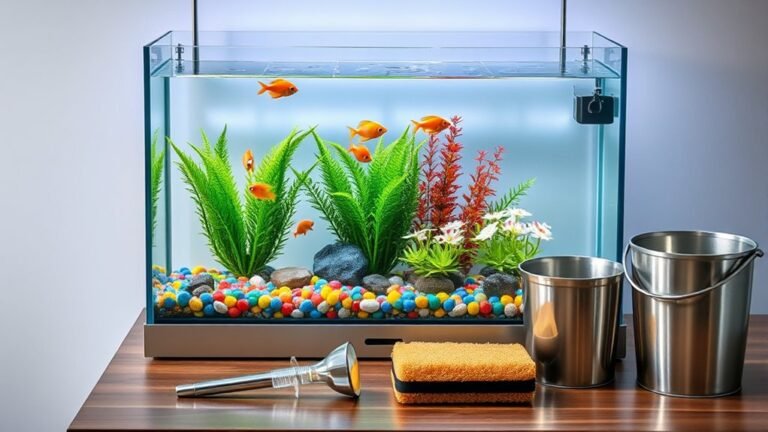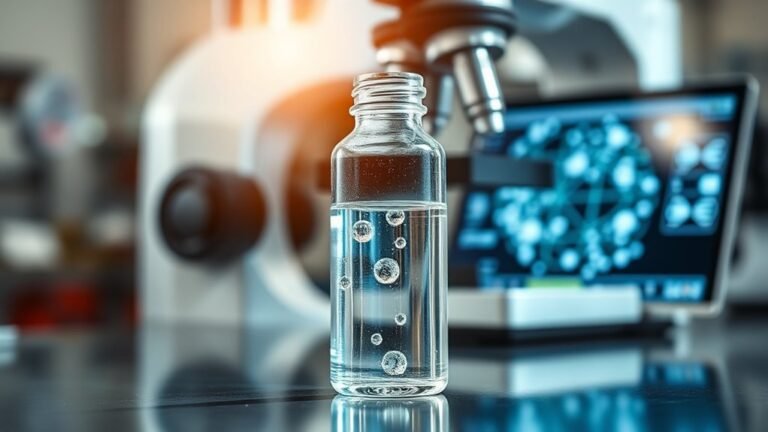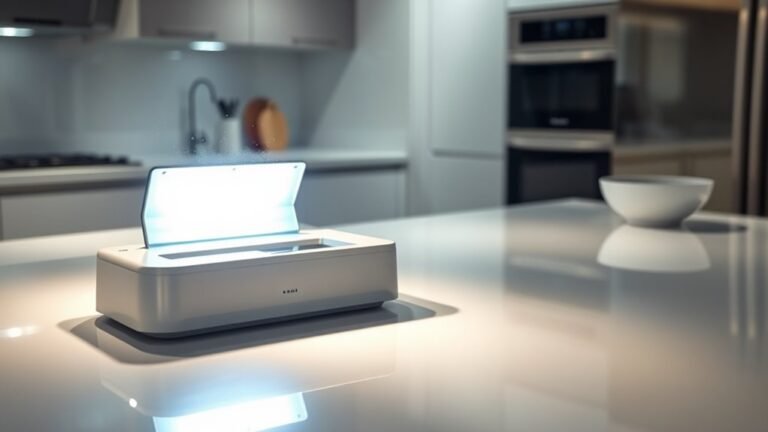Disinfecting High-Touch Areas in Car
When disinfecting high-touch areas in your car, focus on the steering wheel, door handles, gear shift, and control buttons. First, remove personal items and clean visible dirt. Use EPA-approved disinfectants compatible with your interior materials, applying them with microfiber cloths to avoid damage. Let surfaces stay wet for the recommended time before drying. Regularly disinfect at least weekly, increasing during illness. Following a systematic, safe method guarantees thorough sanitation—explore further for detailed steps and maintenance tips.
Identifying High-Touch Areas in Your Vehicle

Before you begin disinfecting your car, you need to pinpoint the high-touch areas most likely to harbor germs. Focus on surfaces frequently contacted during driving and entry, such as the steering wheel, gear shift, door handles, and control buttons. These high touch surfaces accumulate bacteria and viruses due to constant contact. Consider the interior materials too—leather, plastic, and fabric each require specific cleaning approaches to prevent damage while guaranteeing effective disinfection. Don’t overlook seat belts and armrests, which also see repeated use. By systematically identifying these critical zones, you can efficiently target your cleaning efforts without wasting time or resources. This precision guarantees your vehicle’s hygiene supports your freedom to travel safely and confidently, minimizing exposure to harmful pathogens on commonly used interior materials.
Choosing Safe Disinfectant Products for Cars
How do you guarantee the disinfectants you use won’t damage your car’s interior while effectively eliminating germs? Selecting the right product is essential. Consider these steps:
Ensure disinfectants protect your car’s interior while effectively killing germs by choosing compatible, safe products.
- Evaluate the material compatibility of both natural disinfectants and commercial products; avoid harsh chemicals on leather or delicate plastics.
- Check the efficacy against viruses and bacteria—look for EPA-approved commercial products or scientifically supported natural disinfectants.
- Review ingredient lists to exclude substances that could degrade surfaces or cause discoloration.
- Opt for products with quick drying times to minimize residue and maintain your vehicle’s freedom from sticky films.
Preparing Your Car for Disinfection

Proper preparation is essential to guarantee effective disinfection of your car’s interior surfaces. Begin by removing all personal items and trash to expose every high-touch area. Perform a preliminary car cleaning to eliminate visible dirt and debris, as disinfectants work best on clean surfaces. Ventilate the car by opening windows or doors to facilitate airflow during the process. Next, verify your disinfectant selection aligns with your car’s interior materials to prevent damage; check manufacturer guidelines and ingredients for compatibility. Equip yourself with appropriate protective gloves to maintain safety. This methodical setup allows the disinfectant to act efficiently on contact points, promoting a thorough and lasting sanitization while preserving your vehicle’s integrity and your freedom to travel safely.
Step-by-Step Guide to Cleaning the Steering Wheel
To thoroughly clean your steering wheel, follow a systematic approach that targets all surfaces without damaging the material. Begin by selecting appropriate cleaning tools, such as microfiber cloths and a gentle cleaner compatible with your steering wheel’s finish. Then proceed with these steps:
Thoroughly clean your steering wheel using gentle, compatible cleaners and microfiber cloths to protect its finish.
- Wipe the steering wheel with a dry microfiber cloth to remove loose dirt and dust.
- Apply a small amount of cleaner to a damp cloth, never directly on the wheel.
- Gently scrub the entire surface, focusing on textured areas and seams.
- Use a clean, dry cloth to remove excess moisture and residues, ensuring no slippery film remains.
This method preserves your steering wheel’s integrity while delivering a thorough clean, empowering your control over a hygienic driving environment.
Effective Methods for Disinfecting Door Handles

After thoroughly cleaning your steering wheel, it’s important to apply a similar level of care to other frequently touched surfaces like door handles. Begin by identifying the door handle materials—commonly metal, plastic, or coated finishes—to select a compatible disinfectant. Use a microfiber cloth dampened with an EPA-approved disinfectant solution, making certain it’s suitable for these materials to avoid damage. Apply the disinfectant evenly, covering all touchpoints, including the inner and outer handles. Allow the solution to remain wet for the manufacturer-recommended contact time to guarantee effective microbial kill. Avoid spraying disinfectant directly onto electronic components near the handles to prevent damage. By methodically applying disinfectant with attention to door handle materials, you maintain both hygiene and the integrity of your vehicle’s surfaces, preserving your freedom to travel safely.
Sanitizing Gear Shifts and Control Buttons
Three key areas demand careful attention when sanitizing gear shifts and control buttons: material type, disinfectant compatibility, and application technique. For effective gear shift sanitization and control button cleaning, follow these steps:
- Identify materials—plastic, leather, or metal—to select appropriate disinfectants that won’t cause damage.
- Use alcohol-based wipes (70% isopropyl alcohol) for quick evaporation and safe disinfection.
- Apply disinfectants gently with microfiber cloths to avoid scratching or degrading surfaces.
- Avoid saturating buttons and gear shift crevices to prevent electrical issues.
Tips for Maintaining a Germ-Free Car Interior
Although regular cleaning is essential, maintaining a germ-free car interior requires consistent attention to high-touch surfaces and ventilation systems. You need to prioritize targeted disinfecting and proper airflow to reduce microbial presence effectively. Here’s a structured approach to germ prevention in your car interior:
| Area | Recommended Action | Rationale |
|---|---|---|
| Steering Wheel | Wipe with alcohol-based wipes | High contact; transmits germs |
| Door Handles | Disinfect daily | Frequent hand contact |
| Air Vents | Clean and replace filters | Prevents airborne contaminants |
| Seat Belts | Use disinfectant spray | Regularly touched fabric |
Following this methodical routine guarantees your car interior remains hygienic, supporting your freedom to travel safely with minimized germ exposure.
Frequency and Best Practices for Regular Disinfection
You should disinfect high-touch areas in your car at least once a day or after any exposure to contaminants. Use effective cleaning techniques such as wiping surfaces with EPA-approved disinfectants, ensuring adequate contact time for germ elimination. Selecting recommended products that are safe for your vehicle’s materials will maintain both cleanliness and surface integrity.
Disinfection Frequency Guidelines
Regularly disinfecting high-touch areas in your car is essential to minimizing contamination and maintaining hygiene. To align with established disinfection protocols and health guidelines, adhere to these frequency recommendations:
- Disinfect surfaces like door handles, steering wheel, and gear shift daily if you use your car frequently.
- Increase disinfection frequency after transporting multiple passengers or carrying items from public places.
- Perform a thorough disinfection weekly, even if usage is low, to prevent microbial buildup.
- Adjust frequency based on exposure risk, such as during flu season or pandemics, to maintain safety and freedom of movement.
Effective Cleaning Techniques
Maintaining the recommended disinfection frequency is only part of effective hygiene; the methods and materials you use greatly impact the outcome. Employ precise disinfection techniques to eliminate pathogens efficiently while preserving your vehicle’s surfaces. Use appropriate cleaning tools like microfiber cloths and soft brushes to avoid damage.
| Task | Recommended Tool |
|---|---|
| Wiping surfaces | Microfiber cloth |
| Scrubbing crevices | Soft-bristled brush |
| Applying disinfectant | Spray bottle or wipes |
Focus on systematic cleaning: first remove debris, then apply disinfectant, allowing adequate contact time before wiping. Regularly sanitize high-touch areas such as steering wheels, door handles, and controls. This approach maximizes microbial reduction and maintains your autonomy over a clean, safe driving environment.
Recommended Cleaning Products
Selecting the right cleaning products is essential for effective disinfection and preserving your vehicle’s interior surfaces. When choosing, consider these factors:
- Eco friendly options: Opt for biodegradable, non-toxic disinfectants that minimize environmental impact without compromising efficacy.
- Brand comparisons: Evaluate products based on active ingredients, contact time, and surface compatibility to guarantee peak performance.
- Frequency: Disinfect high-touch areas like steering wheels and door handles at least once a week, increasing frequency during illness outbreaks.
- Application method: Use microfiber cloths with sprays to avoid surface damage and guarantee even coverage.
Frequently Asked Questions
Can Disinfectants Damage My Car’S Electronic Systems?
You might worry that using disinfectants could harm your car’s electronic systems, but if you choose products with proven disinfectant compatibility, you’ll minimize risks. Electronic system vulnerabilities often stem from harsh chemicals or excessive moisture, so always apply disinfectants carefully with a cloth rather than spraying directly. By understanding these precautions, you can confidently protect your vehicle’s surfaces without compromising its sensitive electronics, ensuring both cleanliness and freedom to drive worry-free.
Are Homemade Disinfectants Safe for Car Interiors?
You should be cautious with homemade solutions, as their ingredients can affect your vehicle’s interior materials differently. Some mixtures may cause discoloration, deterioration, or residue buildup on surfaces like leather, vinyl, or plastic. It is crucial to test any homemade disinfectant on a small, inconspicuous area before wider application. Using formulations with balanced pH and avoiding harsh chemicals will help protect your car’s finish while allowing you the freedom to customize your cleaning approach safely.
How Long Should Disinfectants Remain on Surfaces Before Wiping?
Like a painter letting colors set before blending, you need to respect the disinfectant dwell time on surfaces to maximize efficacy. Typically, this ranges from 30 seconds to 10 minutes, depending on the product. Always check surface compatibility first to avoid damage. Avoid wiping too soon; the disinfectant needs contact time to neutralize pathogens effectively. Following these steps guarantees thorough disinfection while preserving your freedom to use materials safely and confidently.
Is It Necessary to Wear Gloves When Disinfecting My Car?
You don’t always have to wear gloves during disinfection, but choosing the right glove types can enhance safety. Nitrile or latex gloves protect your skin from harsh chemicals used in disinfection techniques. If you prefer freedom and minimal restriction, disposable gloves offer convenience without compromising protection. Always verify gloves fit well, avoid cross-contamination by changing them frequently, and wash your hands thoroughly after completing the process for maximum hygiene and safety.
Can UV Light Effectively Disinfect High-Touch Car Areas?
Think of UV light as a silent guardian, able to zap microbes without a trace. UV effectiveness depends on exposure time and proximity; it can disinfect surfaces if used properly. However, UV safety is essential—direct skin or eye exposure can be harmful, so protective measures are a must. While UV can complement cleaning, it shouldn’t fully replace manual disinfection in high-touch car areas if you want thorough freedom from germs.






